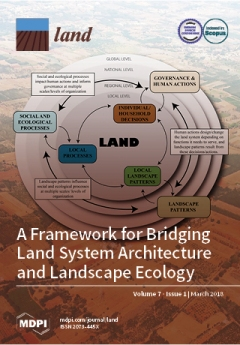Resources
Displaying 2241 - 2245 of 2258A Regional Perspective on Urbanization and Climate-Related Disasters in the Northern Coastal Region of Central Java, Indonesia
Indonesia, as an archipelagic nation, has about 150 million people (60%) living in coastal areas. Such communities are increasingly vulnerable to the effects of change, in the form of sea level rise and stronger, more intense storms. Population growth in coastal areas will also increase the disaster risk mainly because of climate change-related effects such as flooding, droughts, and tidal floods. This study examines the dynamic changes of urban population and urban villages in three decadal periods, from 1990, 2000, to 2010.
Improving Object-Based Land Use/Cover Classification from Medium Resolution Imagery by Markov Chain Geostatistical Post-Classification
Land use/land cover maps derived from remotely sensed imagery are often insufficient in quality for some quantitative application purposes due to a variety of reasons such as spectral confusion. Although object-based classification has some advantages over pixel-based classification in identifying relatively homogeneous land use/cover areas from medium resolution remotely sensed images, the classification accuracy is usually still relatively low.
Acknowledgement to Reviewers of Land in 2017
Peer review is an essential part in the publication process, ensuring that Land maintains high quality standards for its published papers. In 2017, a total of 88 papers were published in the journal.[...]
Land Use and Land Cover Changes and Their Effects on the Landscape of Abaya-Chamo Basin, Southern Ethiopia
This study uses a combination of remote sensing data, field interviews and observations, and landscape indices to examine the dynamics of land use and land cover (LULC), identify their driving forces, and analyze their effects on the landscape of Abaya-Chamo Basin (ACB) between 1985, 1995, and 2010. The results reveal that the landscape of ACB has changed considerably during the past 25 years between 1985 and 2010. The main changes observed imply a rapid reduction in shrubland (28.82%) and natural grassland (33.13%), and an increase in arable land (59.15%).
Moderating Climate Hazard Risk through Cooperation in Asian Drylands
Asia drylands face increasing climate hazard risk, changing socio-economic forces, and environmental challenges that affect community viability. As home to >1 billion residents, deserts are at the centre of the continent’s climate-human predicament. Extreme water scarcity, dependence on food imports and now conflict increase hazard exposure across shared drylands, yet management differs from state to state. This paper argues that a more coherent strategy for mitigating risk would be based on natural environments.


